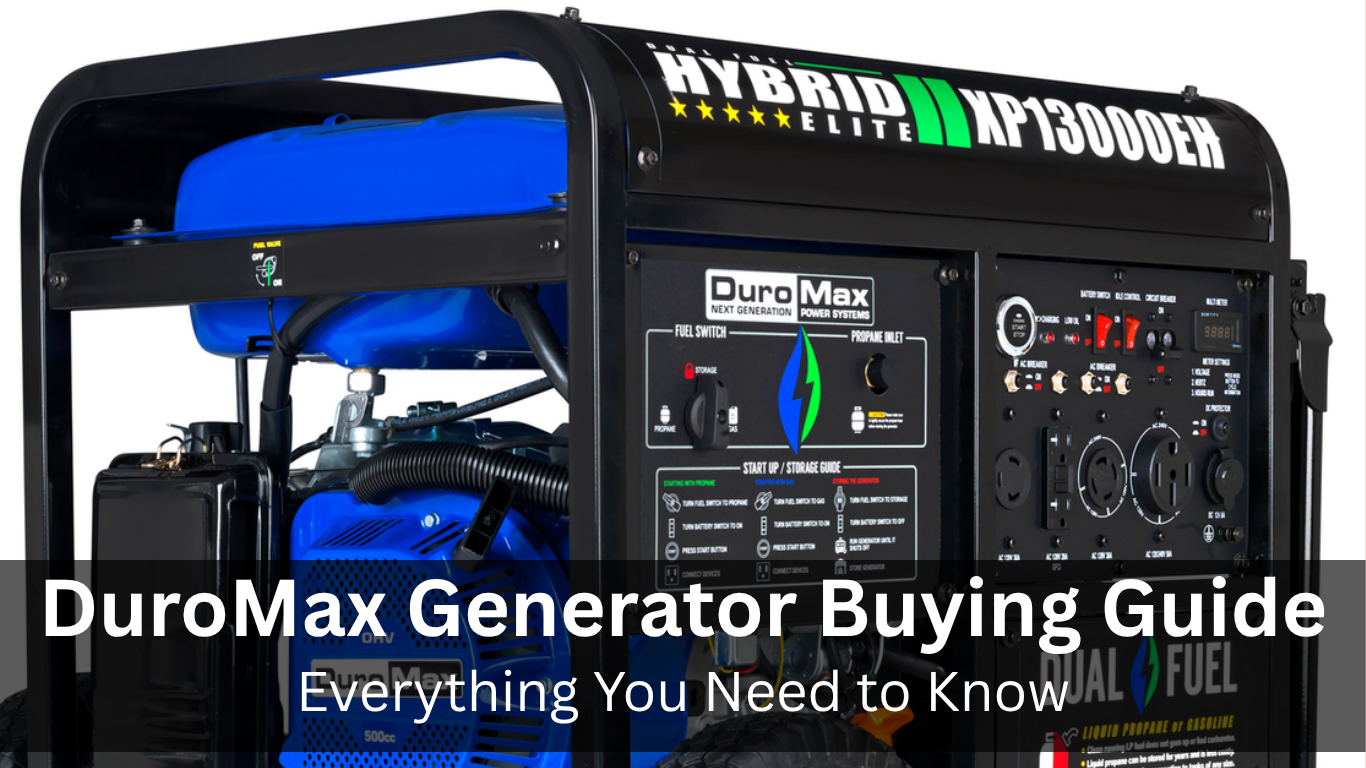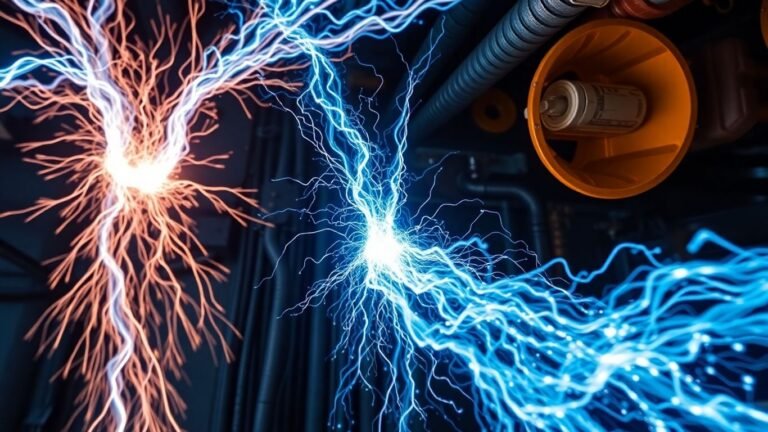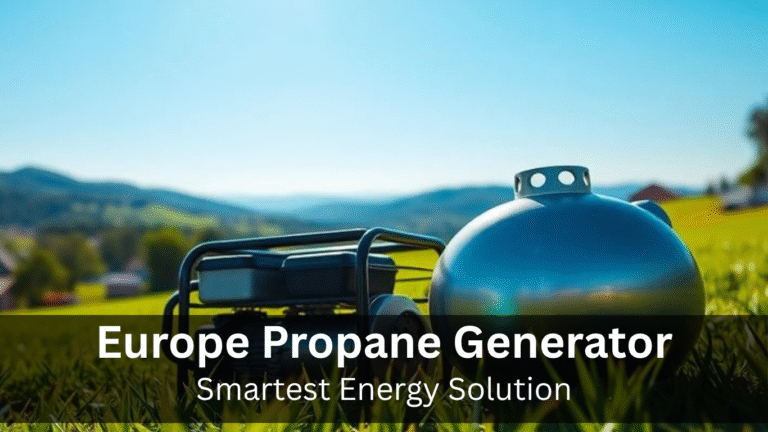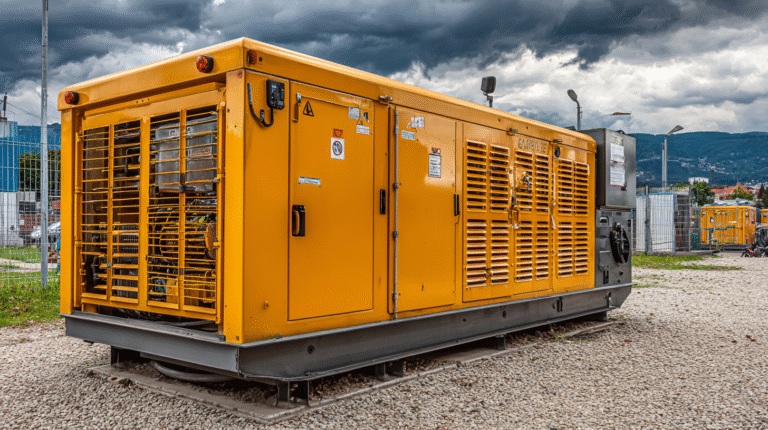DuroMax Generator Buying Guide: Everything You Need to Know
So, you’re thinking about getting a generator, specifically a DuroMax Generator? Good call. These things can be super helpful—whether the power goes out at home, you’re camping, or even need some juice on a job site. But with all the different models out there, picking the right DuroMax Generator can feel a bit much. Don’t worry, we’re going to break it all down for you, making it simple to figure out what you really need.
Key Takeaways
- Figure out your power needs before buying. This means knowing what appliances you want to run and their wattage.
- DuroMax offers different fuel types, like gasoline, propane, or dual fuel. Dual fuel gives you more options.
- Think about features like electric start for convenience and how portable you need your generator to be.
- Match the generator’s size to what you’ll use it for, whether it’s home backup, outdoor fun, or work.
- Regular maintenance is important to keep your DuroMax generator running well and lasting a long time.
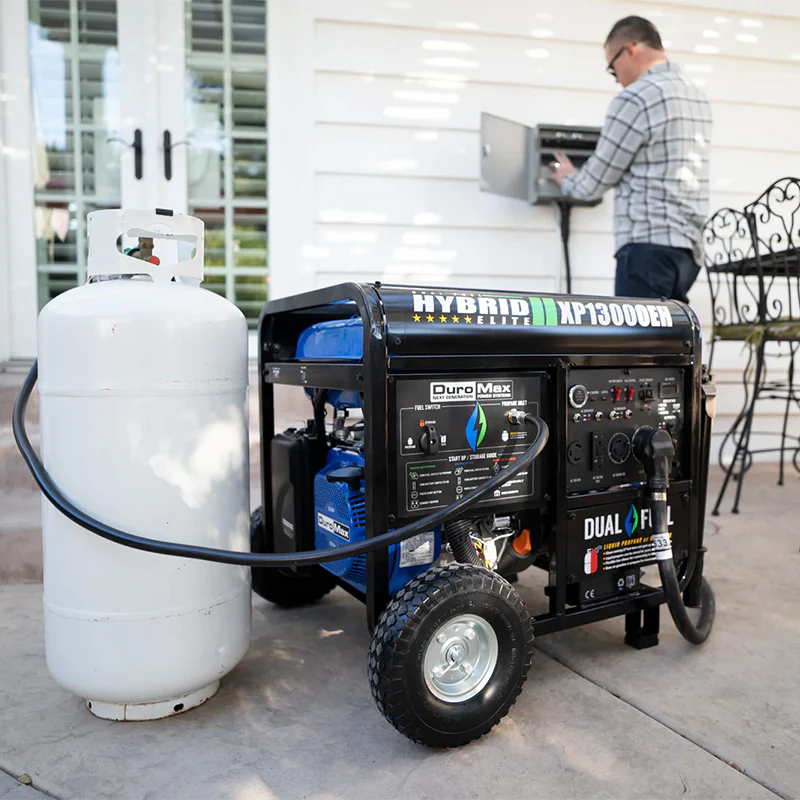
Understanding DuroMax Generator Power Output
Calculating Your Power Needs
Okay, so you’re thinking about getting a DuroMax generator? Smart move. But before you jump in, let’s talk power. You can’t just grab any generator; you need to figure out how much oomph you actually need. Start by making a list of everything you want to power simultaneously. Think about your fridge, lights, maybe a TV, and any other essentials.
- List all appliances
- Note their wattage
- Add them all up
Don’t forget to check the wattage on each appliance – it’s usually on a sticker somewhere. Add up all those wattages, and that’s your baseline. But here’s the kicker: you need to account for starting watts too.
Running Watts Versus Starting Watts
This is where things get a little tricky. Most appliances, especially those with motors (like refrigerators or air conditioners), need a surge of power to get started. This is their starting wattage, and it’s usually higher than their running wattage – the power they need to keep running. A generator needs to handle both the continuous load (running watts) and the initial surge (starting watts). If you ignore starting watts, you’ll end up with a generator that trips every time your fridge kicks on.
Here’s a simple breakdown:
| Wattage Type | Description |
|---|---|
| Running Watts | The continuous power an appliance needs to operate. |
| Starting Watts | The extra power an appliance needs for a short time when it’s first turned on. |
Matching Generator Output to Appliances
Alright, you’ve calculated your total running watts and figured out the highest starting wattage of any single appliance. Now, how do you match that to a DuroMax generator? The key is to choose a generator with a running wattage that exceeds your total running watts and a starting wattage that can handle that initial surge. It’s always better to overestimate slightly than to underestimate. You don’t want to overload your generator, as that can damage both the generator and your appliances.
Think of it like this: your generator is like a muscle. You need enough muscle to lift the weight (running watts) and enough extra power to get the weight off the ground (starting watts). If you try to lift too much, you’ll strain something.
Consider a 50 amp generator if you need to power a small house. Also, remember to check the voltage requirements of your appliances. Most standard household appliances run on 120V, but some heavy-duty appliances might need 240V. Make sure your DuroMax generator has the right outlets for your needs.
DuroMax Generator Fuel Options
When you’re looking at DuroMax generators, one thing you’ll quickly notice is the variety of fuel options available. It’s not just a matter of picking a generator; it’s also about figuring out what fuel source works best for your needs. Let’s break down the common choices.
Gasoline Powered DuroMax Generators
Gasoline-powered generators are probably what most people think of first. They’re widely available, and gasoline provides a good amount of power. DuroMax gasoline generators are easy to refuel, and you can find gas stations pretty much anywhere. Most of these generators use unleaded gasoline, making refills simple. Just check the user manual to be sure.
However, gasoline does have a few downsides. It can degrade over time, especially if stored improperly. Plus, there’s the risk of spills and fumes, so you need to be careful when handling it. Also, gasoline engines can be a bit louder compared to other fuel types.
Propane Powered DuroMax Generators
Propane-powered generators offer a different set of advantages. One of the biggest is that propane has a long shelf life. Unlike gasoline, it doesn’t go bad easily, which is great for emergency backup situations. You can store propane for a long time without worrying about it degrading. Propane also burns cleaner than gasoline, which is better for the environment. For users who prefer a cleaner fuel, propane is a solid choice.
On the flip side, propane generators might not provide quite as much power as gasoline models. You’ll also need a propane tank, which adds to the initial cost and requires safe storage. Plus, finding propane refueling stations might not be as easy as finding gas stations, depending on where you live.
Dual Fuel DuroMax Generator Advantages
Dual fuel generators are where things get really interesting. These generators can run on either gasoline or propane, giving you the best of both worlds. If gasoline is readily available, you can use that. If you want the long shelf life and cleaner burning of propane, you can switch over. DuroMax dual fuel generators offer flexibility, which is a huge plus for many users.
Having a dual fuel option means you’re not stuck with just one fuel source. This can be a lifesaver during emergencies or in situations where one fuel is harder to get than the other. It’s like having a backup plan for your backup plan.
Most dual fuel models have a simple switch to choose between fuels. Just remember that the power output might be slightly different depending on which fuel you’re using. For example, the DuroMax XP13000EH is a popular dual fuel model.
Here’s a quick comparison table:
| Feature | Gasoline | Propane | Dual Fuel |
|---|---|---|---|
| Availability | High | Moderate | High |
| Shelf Life | Short | Long | Varies by fuel |
| Power Output | High | Moderate | Varies by fuel |
| Environmental Impact | Higher | Lower | Varies by fuel |
| Fuel Storage | Requires Stabilizer | Simple | Depends on fuel stored |
Choosing the right fuel option depends on your specific needs and priorities. Consider how often you’ll use the generator, what kind of power you need, and how easy it is to access each fuel type. With DuroMax, you’ve got options to find the perfect fit.
Key Features of DuroMax Generators
DuroMax generators have a bunch of features that make them a solid choice for different power needs. Let’s check out some of the most important ones.
Electric Start and User Convenience
One of the coolest things about many DuroMax generators is the electric start. No more yanking on a cord! Just turn a key or push a button, and you’re good to go. This is super handy, especially in cold weather or if you’re not the strongest person. Beyond that, they often include user-friendly control panels with clear readouts for voltage, amperage, and runtime. Some models even come with remote start capabilities, adding another layer of convenience.
Portability and Design Considerations
DuroMax generators are built with portability in mind, though some are definitely easier to move than others. Many models come with wheel kits and fold-down handles, making them easier to move around a job site or your property. The design is usually pretty rugged, with steel frames to protect the engine and components.
Here’s a quick look at some common portability features:
- Wheel Kits: Standard on many models.
- Fold-Down Handles: For easier storage and transport.
- Lifting Points: Some larger units have these for moving with equipment.
Noise Levels and Operation Environment
Okay, let’s be real: generators aren’t exactly known for being quiet. DuroMax generators are no exception, but some models are designed to be quieter than others. Look for models with noise dampening features or inverter technology if noise is a big concern. Keep in mind that the operating environment plays a big role too. Running a generator in an open space will be louder than running it in a more enclosed area (though you always need to prioritize ventilation for safety!).
It’s important to remember that generator noise is measured in decibels (dB). A lower dB rating means a quieter generator. Check the specs carefully and consider where you’ll be using the generator to determine if the noise level is acceptable.
Selecting the Right DuroMax Generator Size
Choosing the correct generator size is super important. You don’t want to end up with something that can’t handle your needs, or waste money on a huge generator that’s way overkill. It’s all about finding that sweet spot where you have enough power without going overboard. Let’s break down how to figure out what size DuroMax generator is right for you.
Assessing Home Backup Requirements
Okay, so the power goes out. What absolutely needs to keep running? Fridge? Lights? Maybe the TV? Make a list. Then, figure out how many watts each of those things needs. This is where you’ll determine the minimum generator size you need for home backup.
Here’s a basic example:
- Refrigerator: 600 watts (running), 1800 watts (starting)
- Lights (a few): 200 watts
- TV: 150 watts
- Laptop Charger: 50 watts
Add up the running watts (600 + 200 + 150 + 50 = 1000 watts). Then, find the appliance with the highest starting wattage (in this case, the fridge at 1800 watts). Add that to your running watts total (1000 + 1800 = 2800 watts). So, you’d need a generator that can handle at least 2800 watts. But it’s always good to have some headroom, so maybe aim for 3000 watts or more. Consider a portable power station for smaller needs.
Powering Outdoor Activities with DuroMax
Planning a camping trip or tailgating party? A smaller, more portable generator is probably what you need. Think about what you’ll be powering. A small DuroMax generator can handle things like:
- Portable grill
- Speakers
- Phone chargers
- String lights
For outdoor activities, you might not need as much power as you would for home backup. A generator in the 2000-3000 watt range could be perfect. Just make sure to check the wattage requirements of everything you plan to use. Also, consider the noise level – you don’t want to be that person at the campsite.
Job Site Power Solutions
Job sites are a whole different ballgame. You’re likely dealing with power tools that need a lot of juice. Things like:
- Circular saws
- Drills
- Air compressors
- Lighting
These tools often have high starting wattage requirements. You’ll probably need a heavy-duty generator in the 5000-watt range or higher. It’s better to overestimate than underestimate when it comes to job site power. You don’t want to trip breakers or damage your equipment. A larger capacity generator is a must for these situations.
When in doubt, go bigger. It’s better to have extra power than not enough. Plus, you can always add more devices later without having to upgrade your generator. Just be mindful of fuel consumption and storage if you go with a really large model.
DuroMax Generator Maintenance Essentials
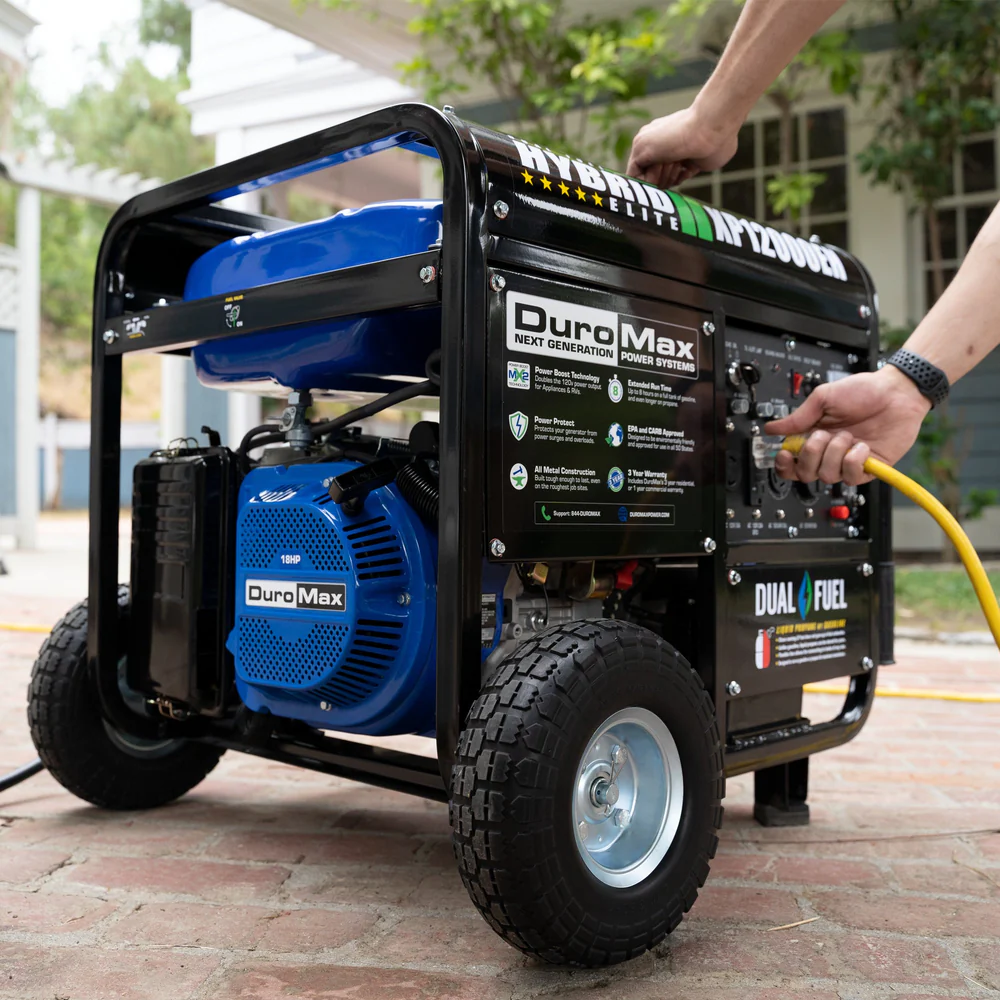
Okay, so you’ve got your DuroMax generator. Great! But don’t think you’re done. Like any piece of machinery, these things need some love to keep them running smoothly. Neglecting maintenance is a surefire way to shorten its lifespan and end up stranded when you need it most. Let’s talk about what it takes to keep your DuroMax in tip-top shape.
Routine Service for Longevity
Regular maintenance is key to extending the life of your DuroMax generator. Think of it like changing the oil in your car – you wouldn’t skip that, would you? Here’s a basic rundown:
- Oil Changes: Follow the manufacturer’s recommendations for oil type and change intervals. Usually, it’s after the first 25 hours of use, then every 50-100 hours after that. Dirty oil can cause serious engine damage. Make sure to check your oil check and change schedules.
- Air Filter: A clean air filter ensures proper airflow to the engine. Check it regularly and clean or replace it as needed. A clogged filter can reduce performance and fuel efficiency.
- Spark Plug: Inspect the spark plug periodically. A fouled or worn spark plug can cause starting problems. Replace it if necessary.
- Fuel Filter: Keep an eye on the fuel filter. A clean fuel filter helps prevent contaminants from entering the engine.
Proper Storage Techniques
How you store your generator when it’s not in use is just as important as how you maintain it while it is. Here’s the deal:
- Drain the Fuel: If you’re not planning on using the generator for an extended period (like over the winter), drain the fuel tank and carburetor. Old fuel can gum up the works and cause starting problems down the road.
- Fuel Stabilizer: If you prefer to leave fuel in the tank, add a fuel stabilizer. This will help prevent the fuel from breaking down and causing deposits.
- Clean the Generator: Wipe down the exterior of the generator to remove any dirt, dust, or debris. This will help prevent corrosion.
- Cover It Up: Store the generator in a dry, covered location. A generator cover will protect it from the elements.
Storing your generator properly is not just about keeping it clean. It’s about preventing future headaches and ensuring it’s ready to go when you need it. Think of it as an investment in reliability.
Troubleshooting Common Issues
Even with the best maintenance, things can still go wrong. Here are a few common issues and how to troubleshoot them:
- Generator Won’t Start: Check the fuel level, spark plug, and air filter. Make sure the choke is in the correct position. If all else fails, consult the owner’s manual or a qualified technician.
- Generator Runs Rough: This could be due to a dirty air filter, fouled spark plug, or old fuel. Try cleaning or replacing these components.
- Generator Overheats: Make sure the generator is properly ventilated. Check the oil level and ensure the cooling fins are clean. Overheating can cause serious engine damage.
- Low Power Output: Check the voltage (120/240 V) of your appliances. This could be due to an overloaded circuit or a faulty component. Consult the owner’s manual or a qualified technician.
Ensuring Safe DuroMax Generator Operation
Operating a DuroMax generator safely is super important. It’s not just about keeping the lights on; it’s about protecting yourself, your family, and your property. Generators can be incredibly useful, but they also pose risks if not handled correctly. Let’s walk through some key safety measures.
Ventilation and Carbon Monoxide Safety
The biggest danger with generators is carbon monoxide (CO) poisoning. CO is an odorless, colorless gas that can kill you in minutes. Never run a generator indoors, in a garage, or even near an open window or door.
Here’s what you need to know:
- Always operate the generator outdoors in a well-ventilated area.
- Position the generator so that the exhaust fumes are directed away from your home and any other buildings.
- Install carbon monoxide detectors inside your home and check them regularly to ensure they are working properly.
I remember one time, my neighbor ran his generator in the garage during a power outage. Luckily, his CO detector went off, and he got everyone out safely. It was a close call, and it really drove home the importance of ventilation.
Electrical Safety Practices
Electricity and water don’t mix, and generators produce a lot of power. Here are some electrical safety tips:
- Use heavy-duty, outdoor-rated extension cords that are in good condition. Check the voltage (120/240 V) of your appliances.
- Avoid overloading the generator by plugging in too many devices at once. Check the wattage ratings of your appliances and compare them to the generator’s capacity.
- Never try to backfeed power into your home’s electrical system by plugging the generator directly into a wall outlet. This is extremely dangerous and can electrocute utility workers.
- Consider using a transfer switch, which allows you to safely connect the generator to your home’s electrical system. A transfer switch ensures that the generator’s power is isolated from the utility grid, preventing backfeeding.
Fuel Handling and Storage
Gasoline and propane are flammable, so it’s important to handle them with care. Here’s how to safely handle and store fuel for your DuroMax generator:
- Always turn off the generator and let it cool down before refueling.
- Refuel the generator outdoors in a well-ventilated area.
- Use a funnel to avoid spills.
- Store gasoline in approved containers in a cool, dry place away from heat sources and open flames.
- Do not store gasoline in your home.
- If you’re using a dual-fuel generator, make sure you understand how to switch between gasoline and propane safely. Always inspect fuel lines for leaks.
| Fuel Type | Storage Recommendations |
Comparing DuroMax Generator Models
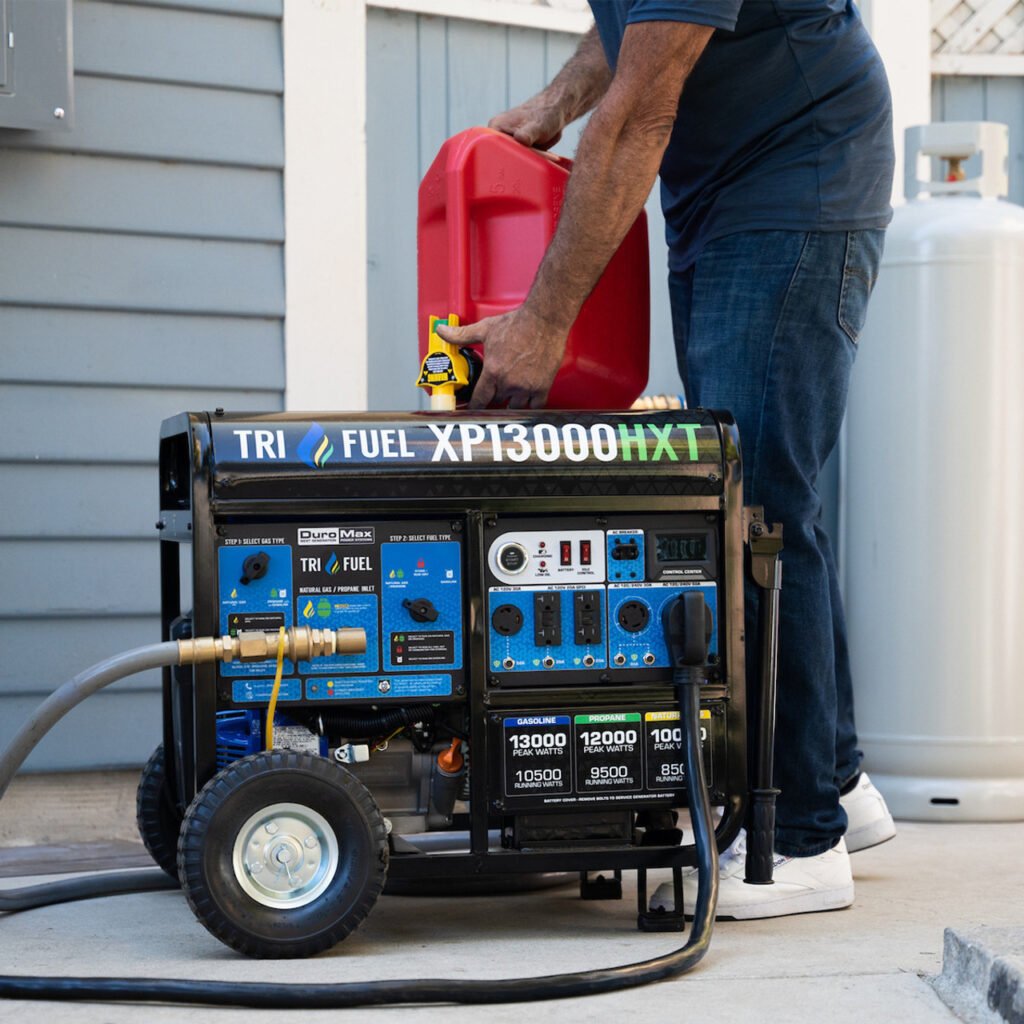
Heavy-Duty DuroMax Options
DuroMax is known for its heavy-duty generators, built to handle demanding power needs. These models often feature larger engines and higher wattage outputs, making them suitable for job sites or as a whole-house diesel generator backup. They’re designed for durability and long run times, often with larger fuel tanks.
Inverter Technology in DuroMax Generators
While DuroMax is recognized for its traditional generators, they also offer models with inverter technology. Inverter generators provide a cleaner, more stable power output, making them safe for sensitive electronics like laptops and smartphones. These models are generally quieter and more fuel-efficient than their conventional counterparts. It’s worth checking the specs to see if a DuroMax inverter generator fits your needs if you need to power sensitive devices.
Value and Performance Analysis
When choosing a DuroMax generator, it’s important to consider the balance between value and performance. Some models offer a great price point for basic power needs, while others provide premium features like electric start or dual-fuel capability at a higher cost. Here’s a quick rundown of what to keep in mind:
- Power Output: Match the wattage to your requirements.
- Fuel Type: Decide between gasoline, propane, or dual-fuel options.
- Features: Consider electric start, portability, and noise levels.
Ultimately, the best DuroMax generator depends on your specific needs and budget. Research different models, read reviews, and compare specifications to make an informed decision.
Wrapping It Up
So, there you have it. Picking a DuroMax generator doesn’t have to be a huge headache. It’s really about figuring out what you need it for. Are you trying to keep your fridge running during a blackout, or do you just need some tunes at the campsite? Once you know that, looking at things like how much power it puts out, what kind of fuel it uses, and how loud it is becomes way easier. Take your time, think about your specific situation, and you’ll find a DuroMax that’s just right. It’s all about getting that reliable power when you need it most.
Frequently Asked Questions
What makes DuroMax generators a good choice?
DuroMax generators are known for being tough and reliable. They often have strong engines and can run on different kinds of fuel, making them good for many uses.
How do I figure out what size DuroMax generator I need?
To figure out what size generator you need, add up the running watts of all the things you want to power at the same time. Then, add the highest starting watts of any single item. Pick a generator that can handle that total amount.
Can DuroMax generators use more than one type of fuel?
Many DuroMax generators can use both gasoline and propane. This is great because if one fuel type isn’t available, you can use the other. Propane also lasts longer in storage.
Do DuroMax generators have an electric start feature?
Yes, many DuroMax models come with an electric start, which means you just push a button to turn them on. This is much easier than pulling a cord.
Where should I operate my DuroMax generator safely?
You should always run your generator outside, far away from windows and doors, to prevent dangerous carbon monoxide from building up inside your home. Make sure there’s plenty of fresh air around it.
What kind of maintenance does a DuroMax generator need?
Regular upkeep, like changing the oil, cleaning the air filter, and checking the spark plug, will help your DuroMax generator last a long time and work well when you need it.

